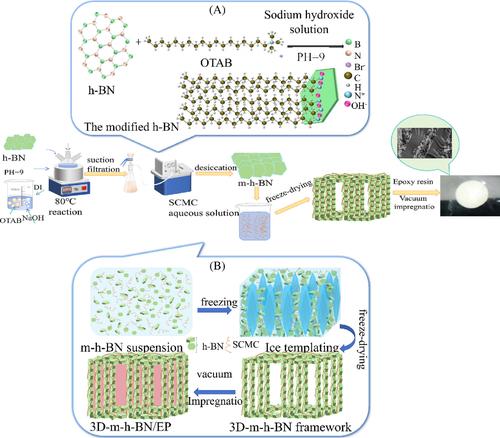当前位置:
X-MOL 学术
›
Polym. Compos.
›
论文详情
Our official English website, www.x-mol.net, welcomes your
feedback! (Note: you will need to create a separate account there.)
Construction of 3D modified hexagonal boron nitride thermal conductivity network by ice template method and research of high heat-conducting coefficient of epoxy resin matrix composite material
Polymer Composites ( IF 4.8 ) Pub Date : 2024-09-27 , DOI: 10.1002/pc.28926 Kexin Chen, Ling Weng, Jinming Liu, Xiaorui Zhang, Lizhu Guan, Ruiqun Pan, Xiaoming Wang
Polymer Composites ( IF 4.8 ) Pub Date : 2024-09-27 , DOI: 10.1002/pc.28926 Kexin Chen, Ling Weng, Jinming Liu, Xiaorui Zhang, Lizhu Guan, Ruiqun Pan, Xiaoming Wang

|
This paper investigates the high thermal conductive properties of modified hexagonal boron nitride (h-BN)/epoxy (EP) composites. Octadecyl trimethyl ammonium bromide as a cationic surfactant modified h-BN and sodium carboxymethylcellulose to build 3D heat transfer framework by the ice template method and preparation of epoxy composites. The h-BN was modified by inter-ionic charge electrostatic attraction to improve the h-BN dispersibility; characterization by scanning electron microscope, transmission electron microscope, zeta potential, x-ray diffraction and Fourier transform infrared spectroscopy proved the success of h-BN surficial modifyment. 3 wt% sodium carboxymethylcellulose was used to construct the optimal 3D modified h-BN network, and the w-BN/EP composites had a very high heat conduction; when the composite material acquired by the ice template method have high heat transfer coefficient, 1.57 W/(m K) for 25 wt% 3D modified h-BN/EP heat transfer coefficient and 0.76 W/(m K) for modified h-BN/EP at the same ratio, which is a 107% enhancement in heat transfer efficiency, and 0.12 W/(m K) for EP, which is a 1208% enhancement in thermal conductivity. The results of thermogravimetric analysis (thermogravimetric analysis and differential thermogravimetric analysis), differential scanning calorimetry, and infrared thermography indicate that the thermostability and rejection of heat of composite material was significantly improved. The variation of dielectric constant was stabilized to ensure lower dielectric loss. Overall, this study can better adapt to high-frequency signal transmission.
中文翻译:

基于冰模板法构建三维改性六方氮化硼导热网络及环氧树脂基复合材料高导热系数研究
本文研究了改性六方氮化硼 (h-BN)/环氧树脂 (EP) 复合材料的高导热性能。十八烷基三甲基溴化铵作为阳离子表面活性剂,经冰模板法修饰h-BN和羧甲基纤维素钠构建3D传热框架,制备环氧树脂复合材料。通过离子间电荷静电吸引对 h-BN 进行改性,以提高 h-BN 分散性;通过扫描电子显微镜、透射电子显微镜、Zeta 电位、X 射线衍射和傅里叶变换红外光谱表征证明了 h-BN 表面改性的成功。使用 3 wt% 羧甲基纤维素钠构建最佳 3D 改性 h-BN 网络,w-BN/EP 复合材料具有非常高的导热性;当通过冰模板法获得的复合材料具有较高的传热系数时,在相同比例下,25 wt% 3D 改性 h-BN/EP 传热系数为 1.57 W/(m K),改性 h-BN/EP 为 0.76 W/(m K),传热效率提高了 107%,EP 为 0.12 W/(m K), 热导率提高了 1208%。热重分析(热重分析和差示热重分析)、差示扫描量热法和红外热成像结果表明,复合材料的热稳定性和散热性得到显著提高。介电常数的变化是稳定的,以确保较低的介电损耗。总体而言,本研究能较好地适应高频信号传输。
更新日期:2024-09-27
中文翻译:

基于冰模板法构建三维改性六方氮化硼导热网络及环氧树脂基复合材料高导热系数研究
本文研究了改性六方氮化硼 (h-BN)/环氧树脂 (EP) 复合材料的高导热性能。十八烷基三甲基溴化铵作为阳离子表面活性剂,经冰模板法修饰h-BN和羧甲基纤维素钠构建3D传热框架,制备环氧树脂复合材料。通过离子间电荷静电吸引对 h-BN 进行改性,以提高 h-BN 分散性;通过扫描电子显微镜、透射电子显微镜、Zeta 电位、X 射线衍射和傅里叶变换红外光谱表征证明了 h-BN 表面改性的成功。使用 3 wt% 羧甲基纤维素钠构建最佳 3D 改性 h-BN 网络,w-BN/EP 复合材料具有非常高的导热性;当通过冰模板法获得的复合材料具有较高的传热系数时,在相同比例下,25 wt% 3D 改性 h-BN/EP 传热系数为 1.57 W/(m K),改性 h-BN/EP 为 0.76 W/(m K),传热效率提高了 107%,EP 为 0.12 W/(m K), 热导率提高了 1208%。热重分析(热重分析和差示热重分析)、差示扫描量热法和红外热成像结果表明,复合材料的热稳定性和散热性得到显著提高。介电常数的变化是稳定的,以确保较低的介电损耗。总体而言,本研究能较好地适应高频信号传输。






























 京公网安备 11010802027423号
京公网安备 11010802027423号